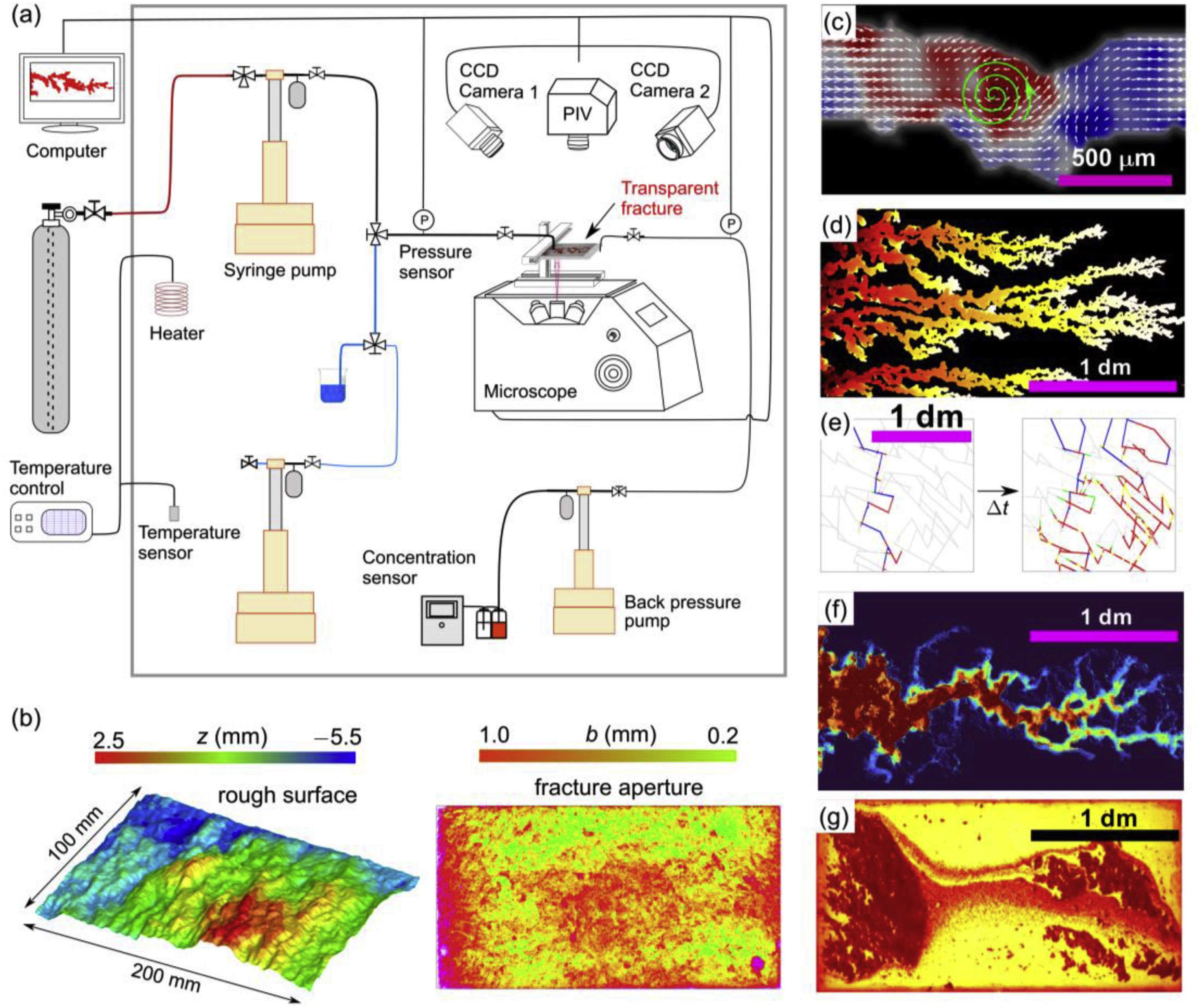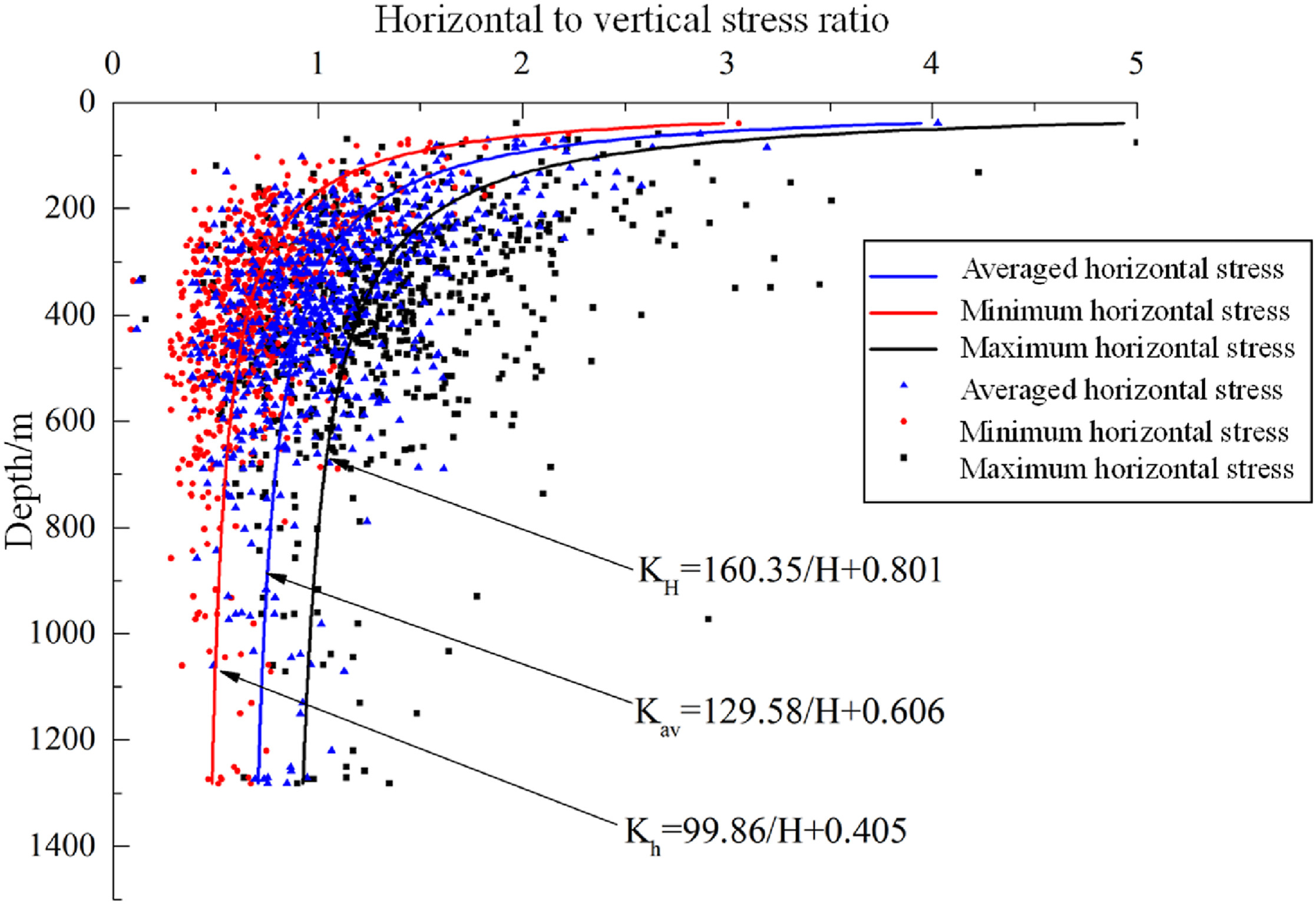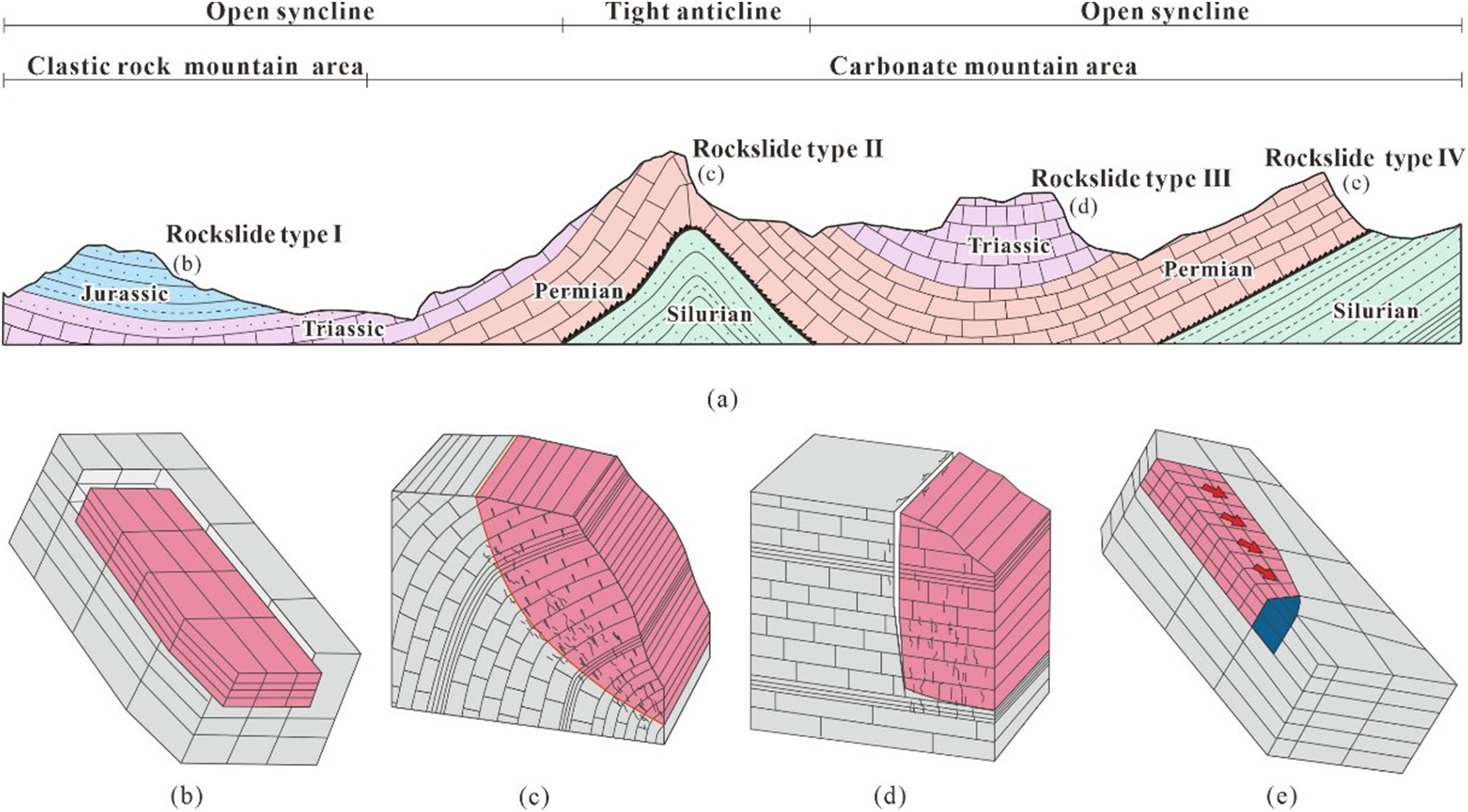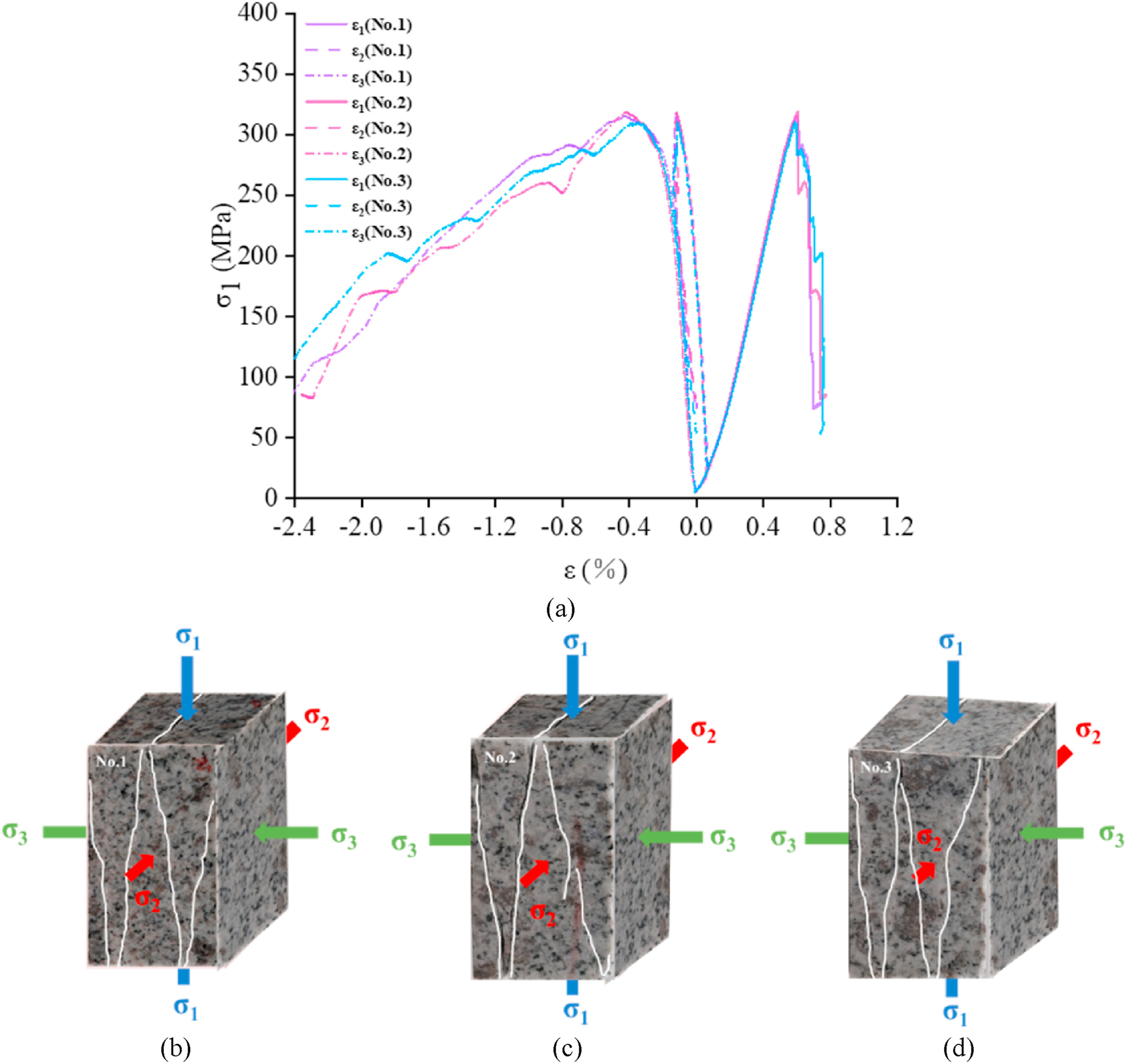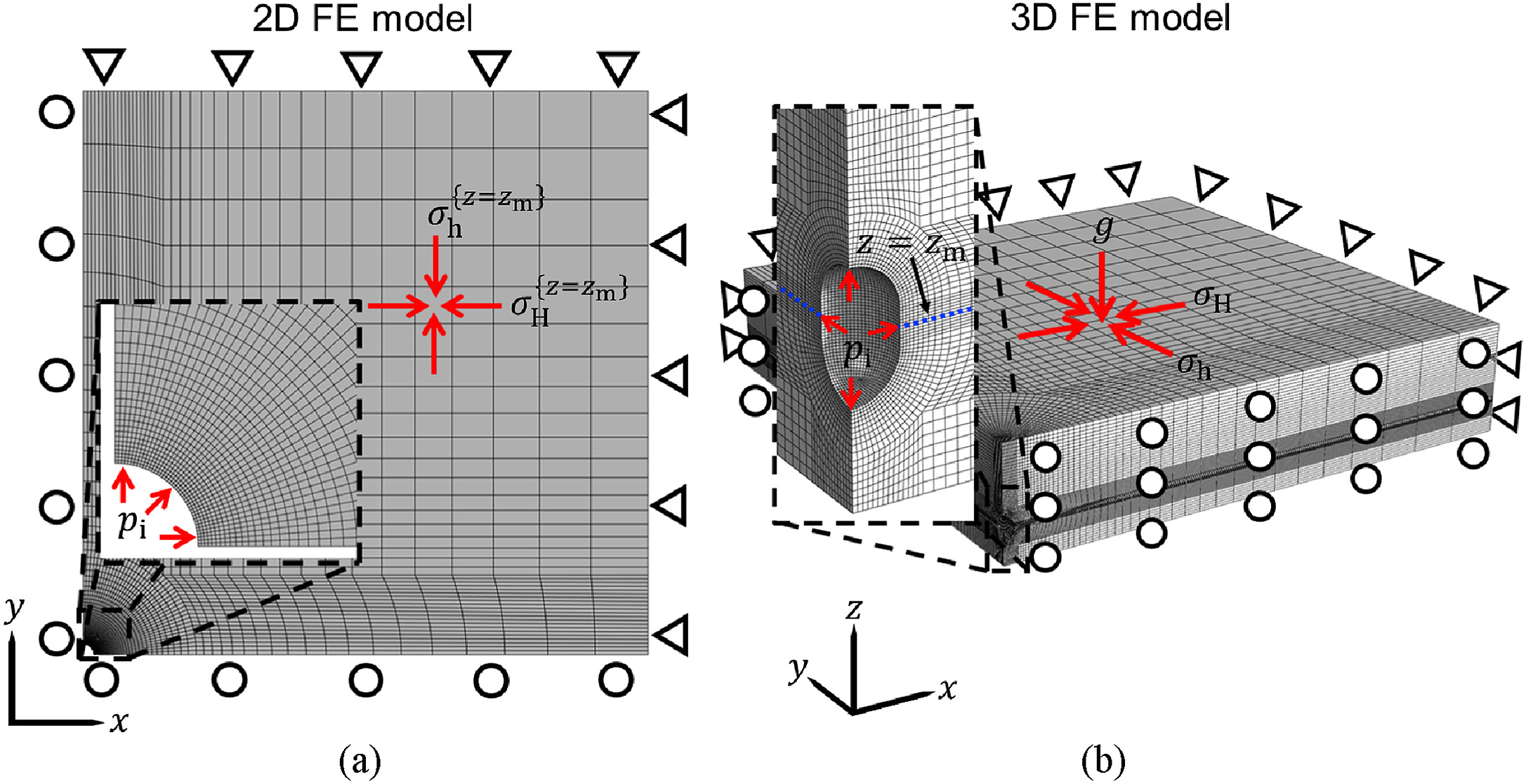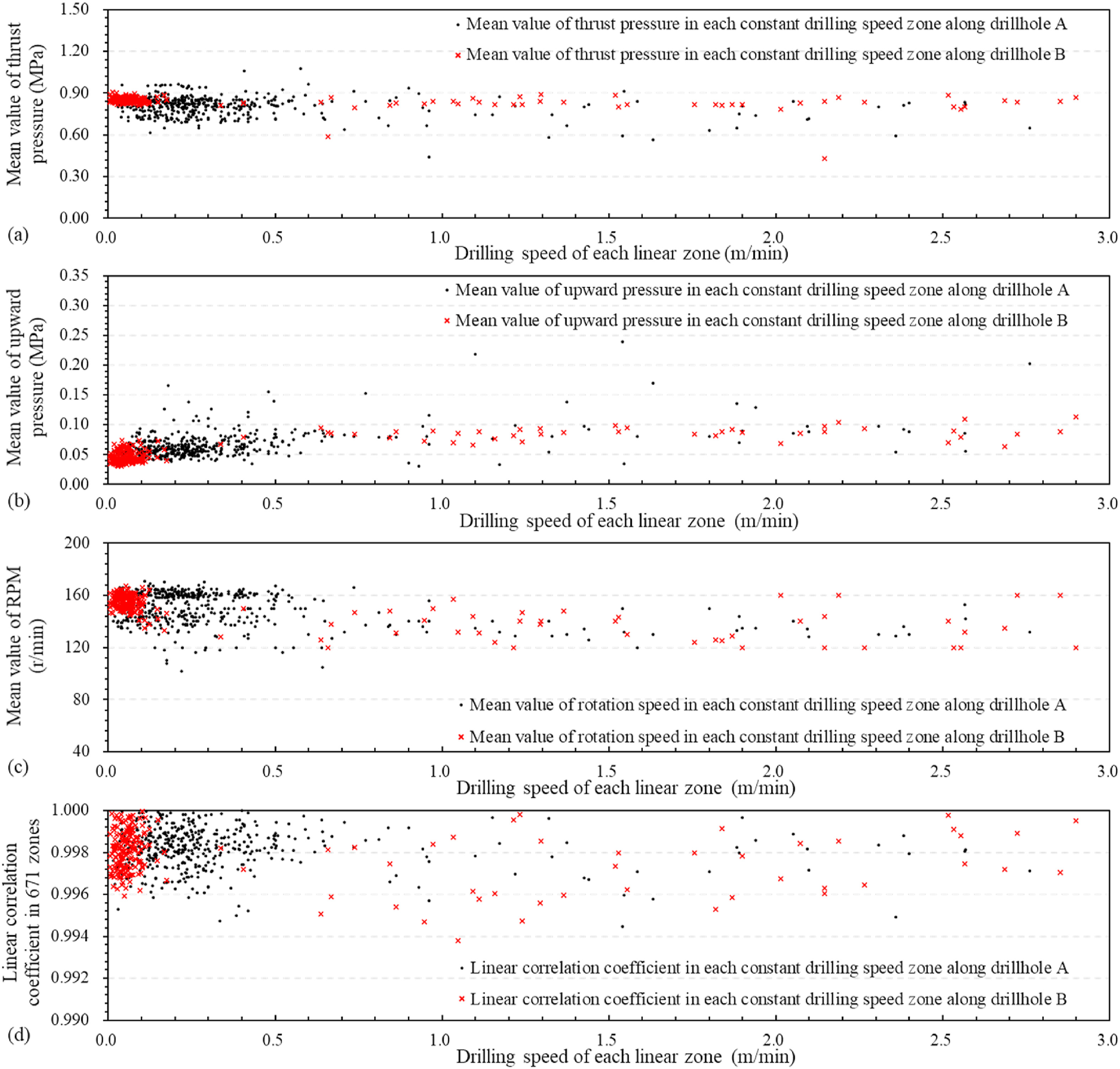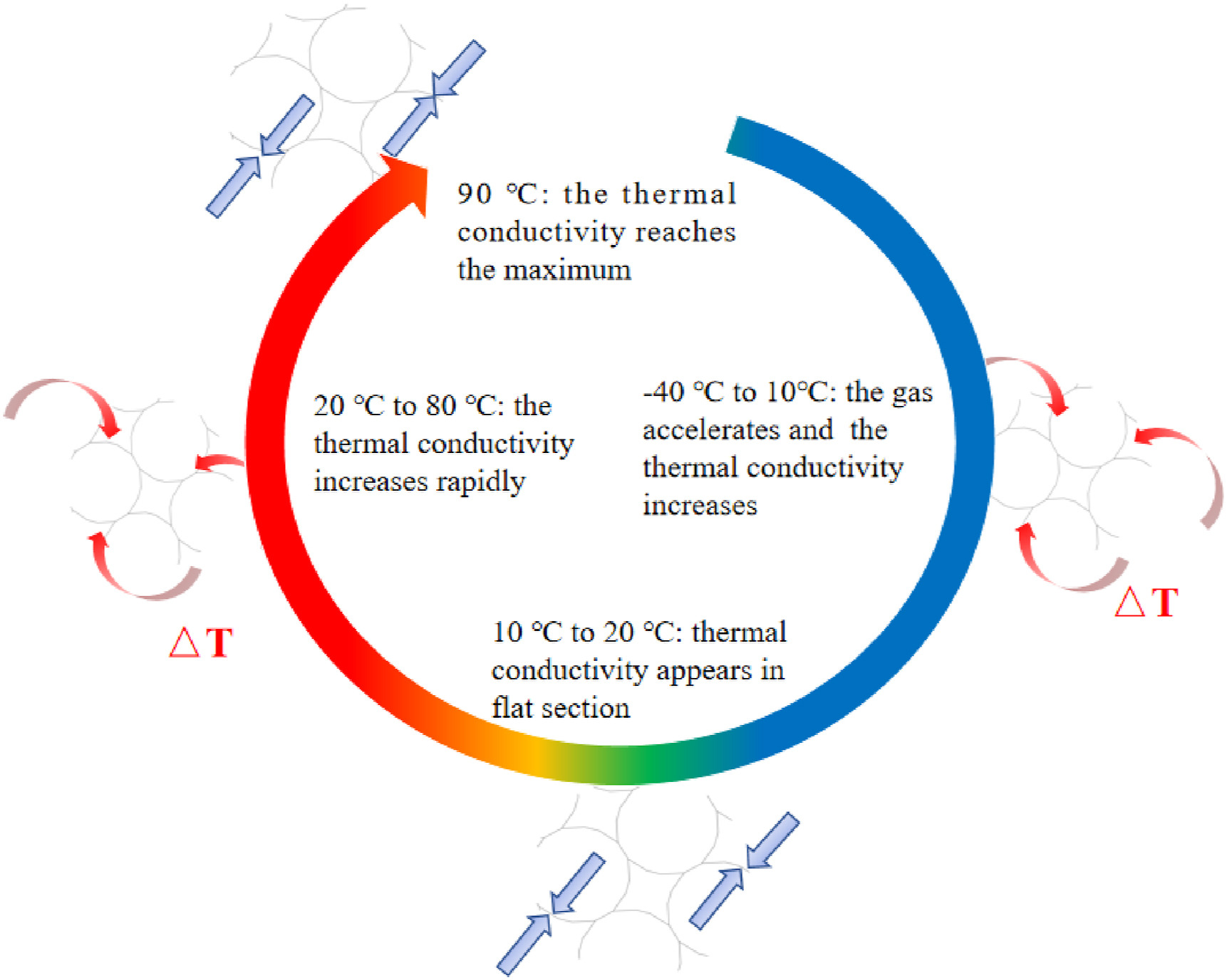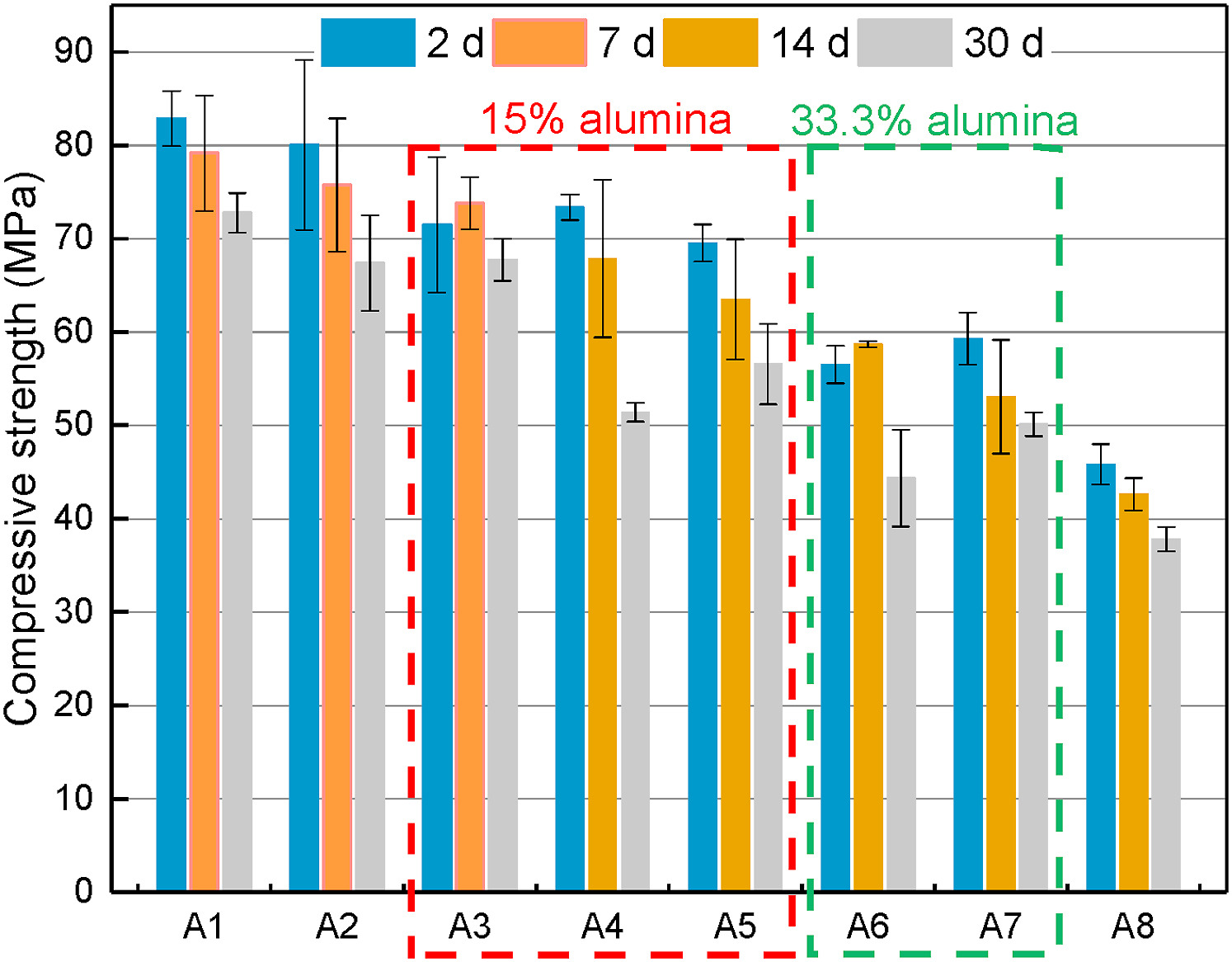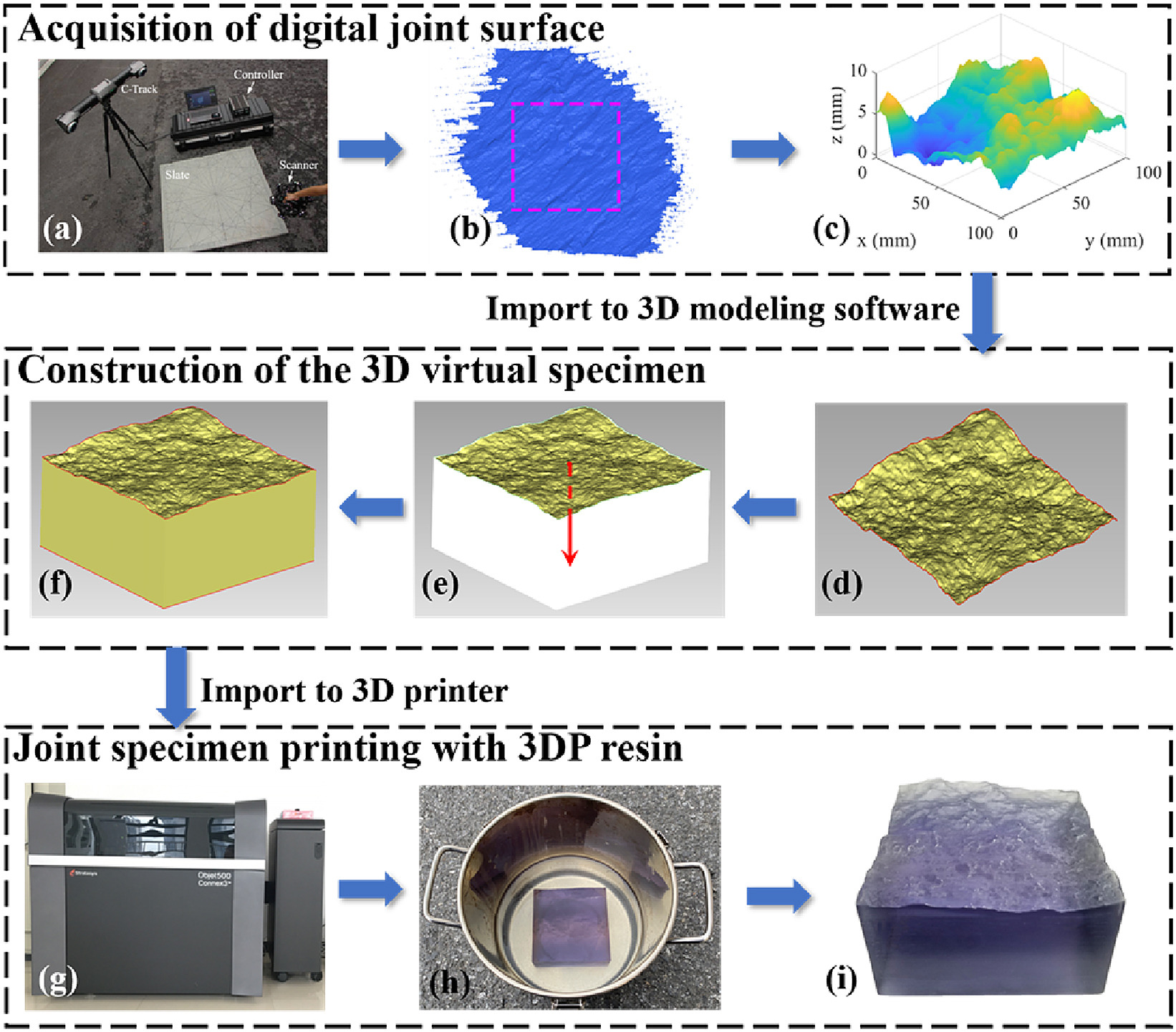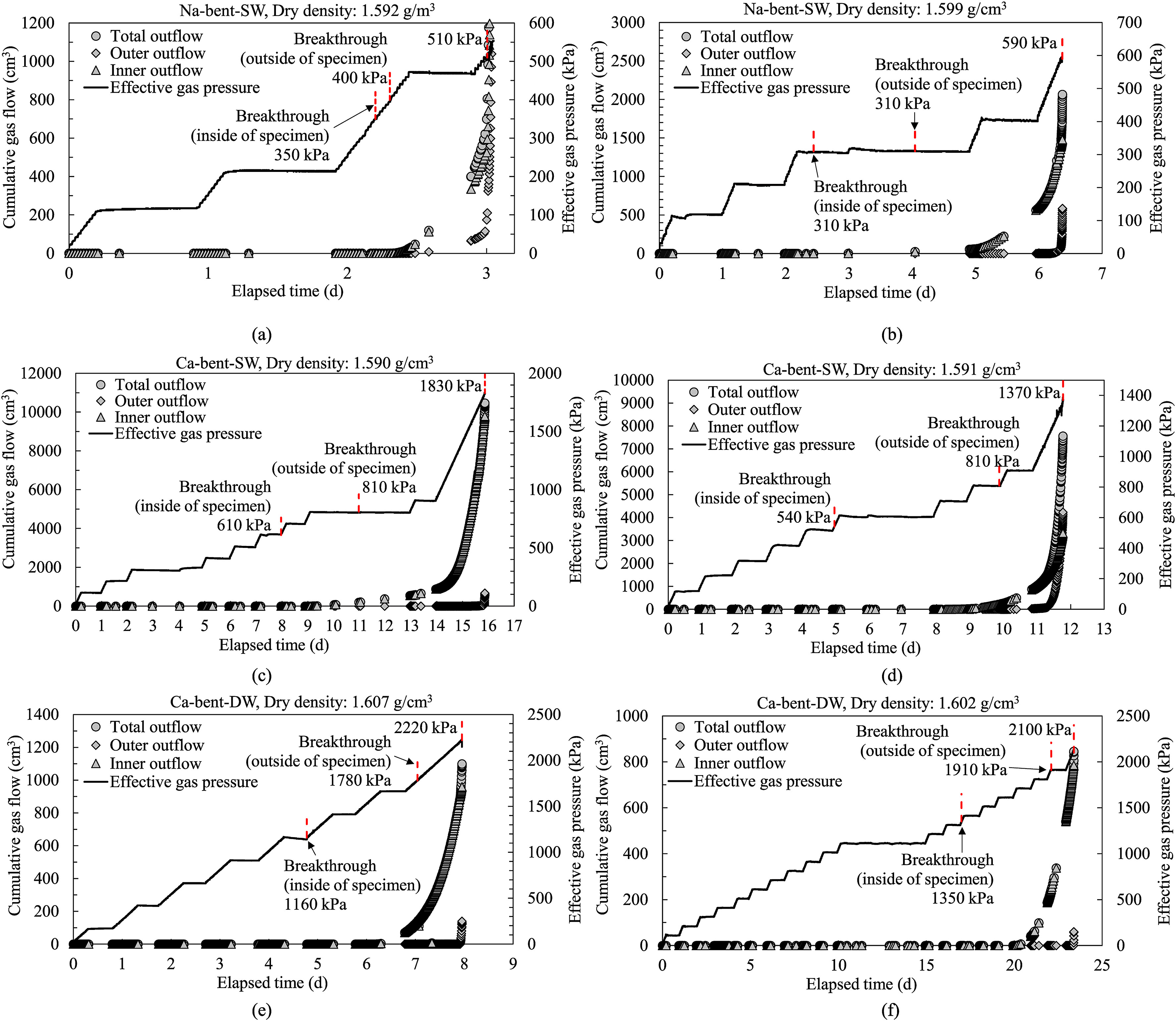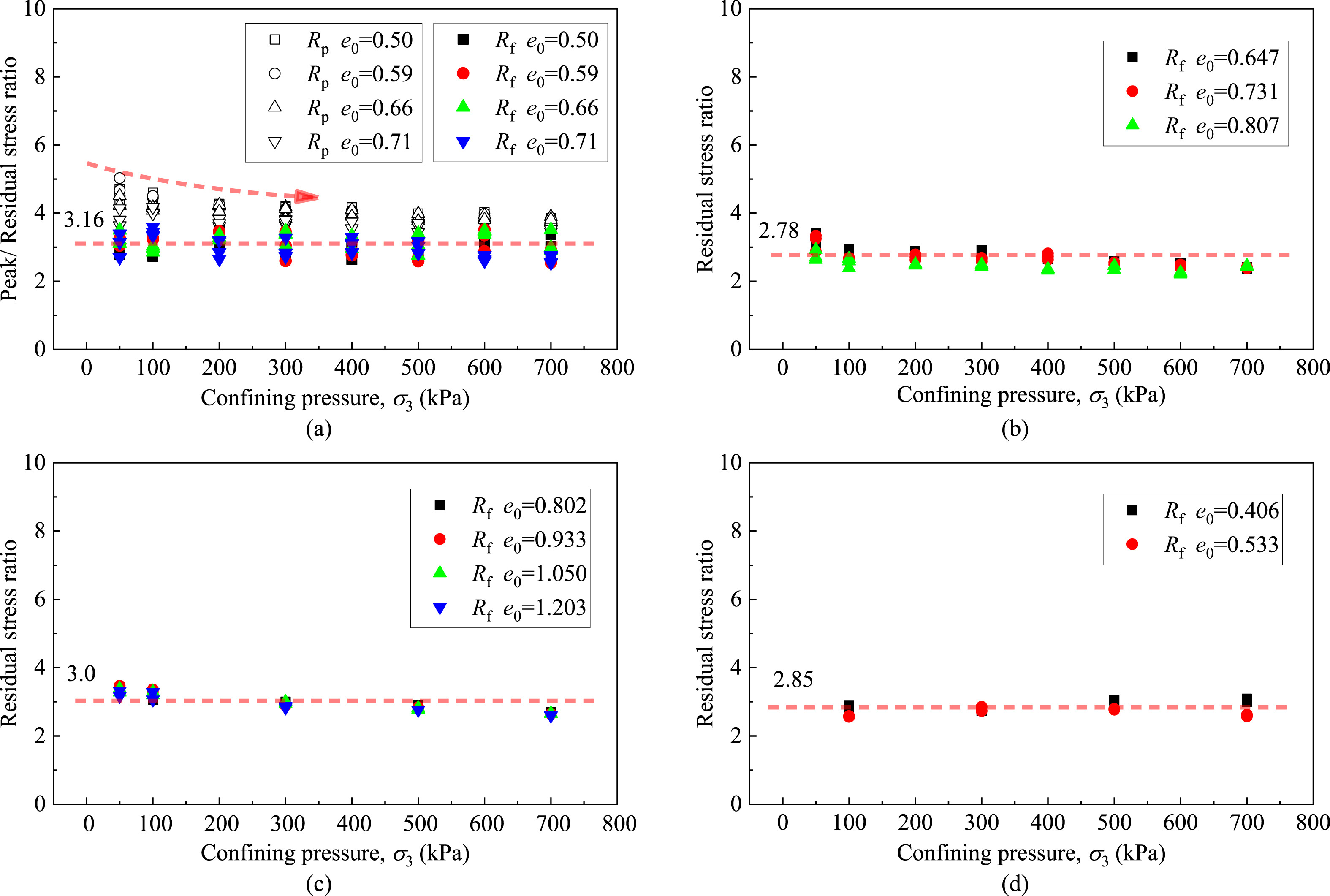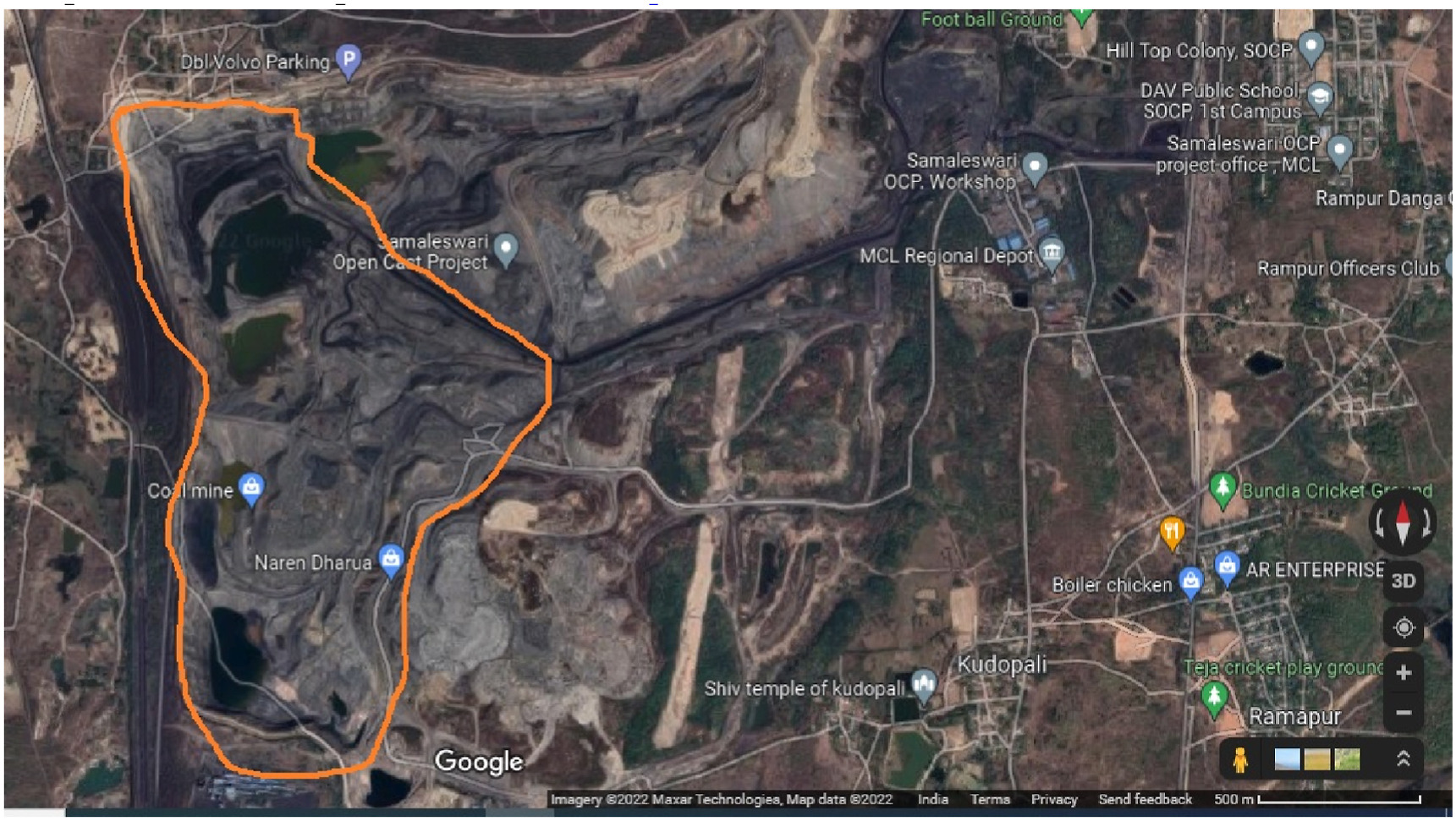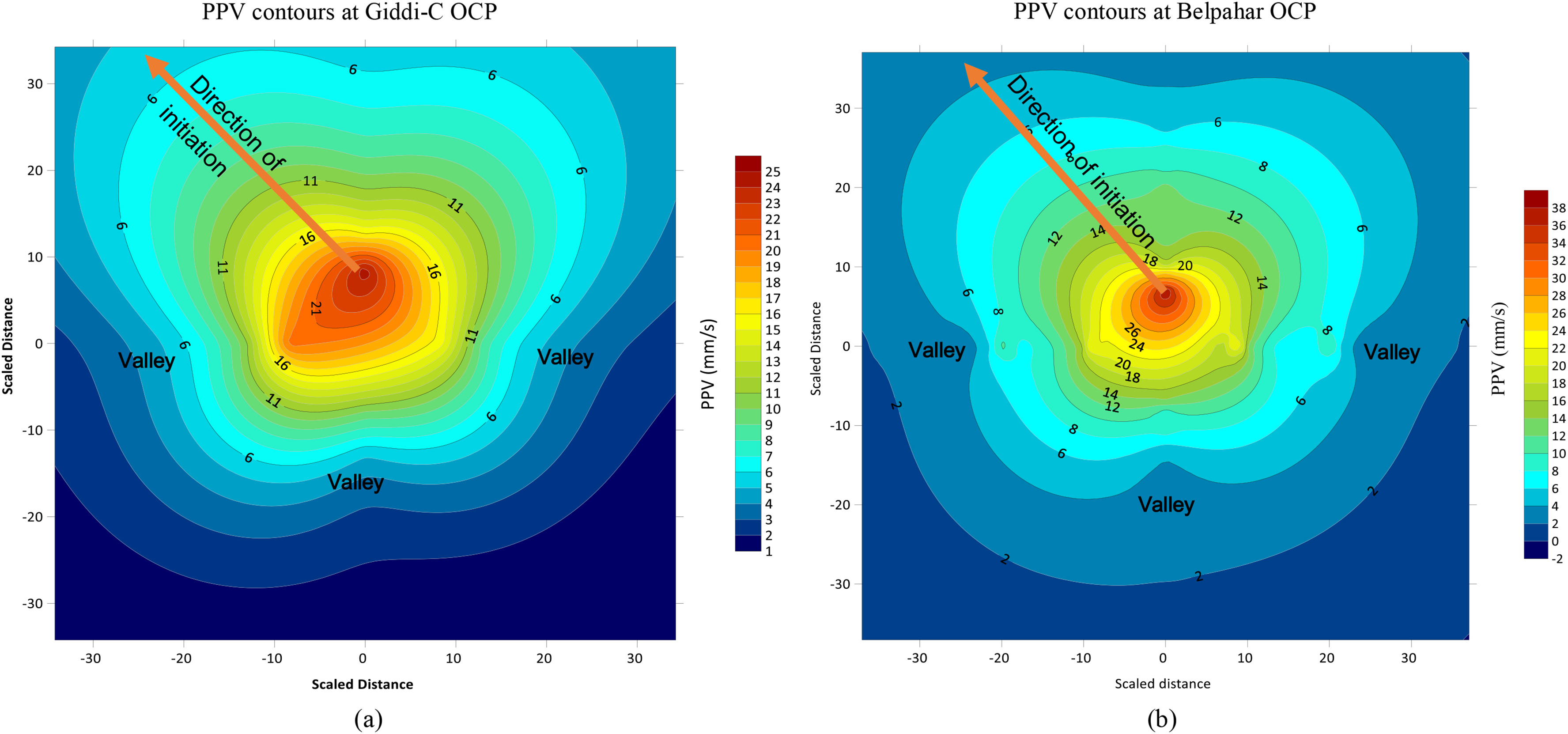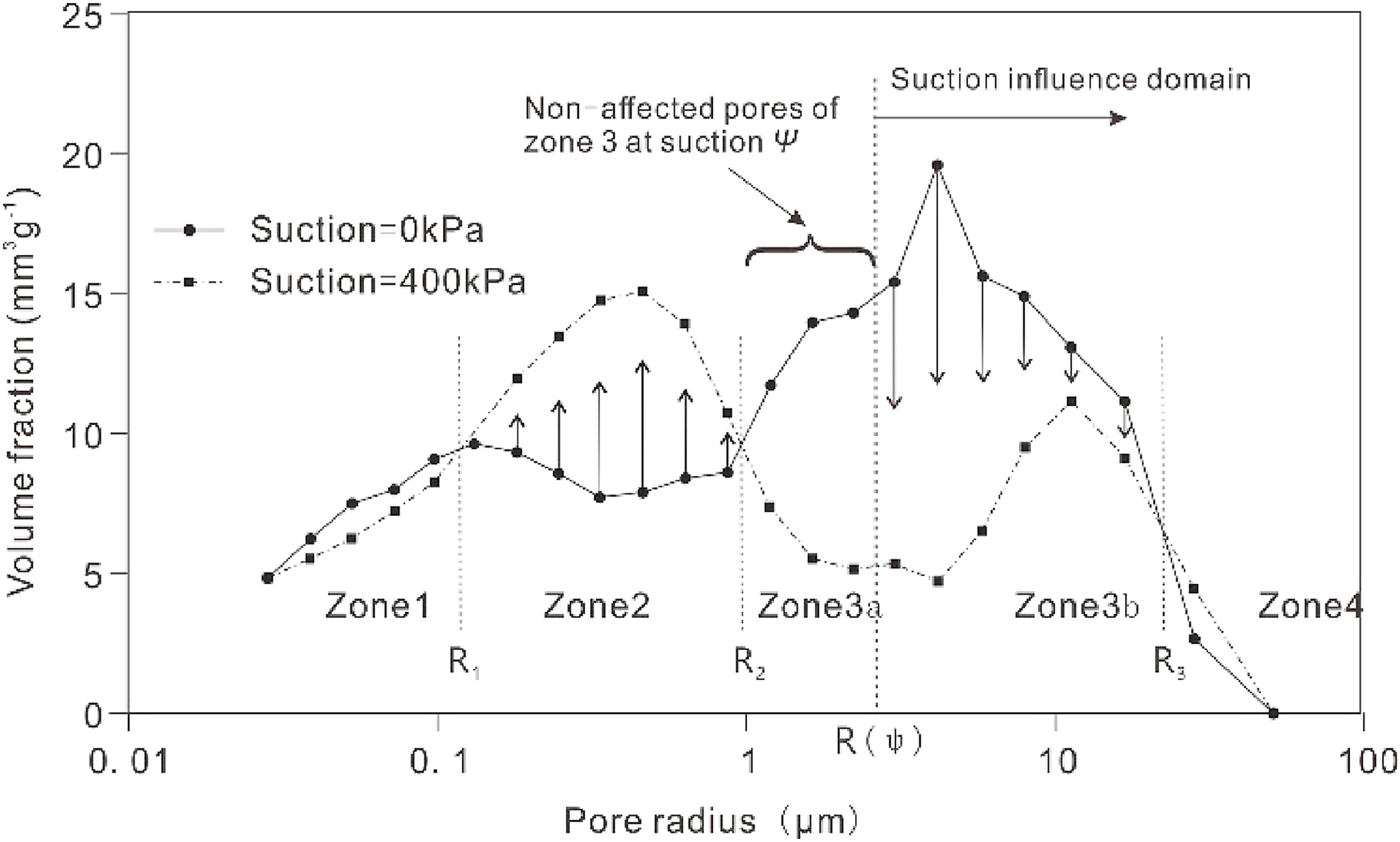-
Groundwater flow through fractured rocks and seepage control in geotechnical engineering: Theories and practices
Chuang-Bing Zhou, Yi-Feng Chen, Ran Hu, Zhibing Yang
2023, 15(1): 1-36. doi:10.1016/j.jrmge.2022.10.001
Abstract: Groundwater flow through fractured rocks has been recognized as an important issue in many geotechnical engineering practices. Several key aspects of fundamental mechanisms, numerical modeling and engineering applications of flow in fractured rocks are discussed. First, the microscopic mechanisms of fluid flow in fractured rocks, especially under the complex conditions of non-Darcian flow, multiphase flow, rock dissoShow FiguresGroundwater flow through fractured rocks has been recognized as an important issue in many geotechnical engineering practices. Several key aspects of fundamental mechanisms, numerical modeling and engineering applications of flow in fractured rocks are discussed. First, the microscopic mechanisms of fluid flow in fractured rocks, especially under the complex conditions of non-Darcian flow, multiphase flow, rock dissolution, and particle transport, have been revealed through a combined effort of visualized experiments and theoretical analysis. Then, laboratory and field methods of characterizing hydraulic properties (e.g. intrinsic permeability, inertial permeability, and unsaturated flow parameters) of fractured rocks in different flow regimes have been proposed. Subsequently, high-performance numerical simulation approaches for large-scale modeling of groundwater flow in fractured rocks and aquifers have been developed. Numerical procedures for optimization design of seepage control systems in various settings have also been proposed. Mechanisms of coupled hydro-mechanical processes and control of flow-induced deformation have been discussed. Finally, three case studies are presented to illustrate the applications of the improved theoretical understanding, characterization methods, modeling approaches, and seepage and deformation control strategies to geotechnical engineering projects.
[...]Read more. -
Mechanical behaviors of coal measures and ground control technologies for China's deep coal mines – A review
Hongpu Kang, Fuqiang Gao, Gang Xu, Huaiwei Ren
2023, 15(1): 37-65. doi:10.1016/j.jrmge.2022.11.004
Abstract: This paper reviews the major achievements in terms of mechanical behaviors of coal measures, mining stress distribution characteristics and ground control in China's deep underground coal mining. The three main aspects of this review are coal measure mechanics, mining disturbance mechanics, and rock support mechanics. Previous studies related to these three topics are reviewed, including the geomechanical propertiesShow FiguresThis paper reviews the major achievements in terms of mechanical behaviors of coal measures, mining stress distribution characteristics and ground control in China's deep underground coal mining. The three main aspects of this review are coal measure mechanics, mining disturbance mechanics, and rock support mechanics. Previous studies related to these three topics are reviewed, including the geomechanical properties of coal measures, distribution and evolution characteristics of mining-induced stresses, evolution characteristics of mining-induced structures, and principles and technologies of ground control in both deep roadways and longwall faces. A discussion is made to explain the structural and mechanical properties of coal measures in China's deep coal mining practices, the types and distribution characteristics of in situ stresses in underground coal mines, and the distribution of mining-induced stress that forms under different geological and engineering conditions. The theory of pre-tensioned rock bolting has been proved to be suitable for ground control of deep underground coal roadways. The use of combined ground control technology (e.g. ground support, rock mass modification, and destressing) has been demonstrated to be an effective measure for rock control of deep roadways. The developed hydraulic shields for 1000 m deep ultra-long working face can effectively improve the stability of surrounding rocks and mining efficiency in the longwall face. The ground control challenges in deep underground coal mines in China are discussed, and further research is recommended in terms of theory and technology for ground control in deep roadways and longwall faces.
[...]Read more. -
Geostructures, dynamics and risk mitigation of high-altitude and long-runout rockslides
Yueping Yin, Bin Li, Yang Gao, Wenpei Wang, Shilin Zhang, Nan Zhang
2023, 15(1): 66-101. doi:10.1016/j.jrmge.2022.11.001
Abstract: Long-runout rockslides at high altitude could cause disaster chain in river basins and destroy towns and major infrasturctures. This paper firstly explores the initiation mechanism of high-altitude and long-runout rockslides. Two types of sliding-prone geostructure models, i.e. the fault control type in orogenic belt and the fold control type in platform area, are proposed. Then, large-scale experimental apparatus anShow FiguresLong-runout rockslides at high altitude could cause disaster chain in river basins and destroy towns and major infrasturctures. This paper firstly explores the initiation mechanism of high-altitude and long-runout rockslides. Two types of sliding-prone geostructure models, i.e. the fault control type in orogenic belt and the fold control type in platform area, are proposed. Then, large-scale experimental apparatus and associated numerical simulations are conducted to understanding the chain-style dynamics of rockslide-debris avalanche-debris flow. The results reveal the fragmentation effects, the rheological behaviors and the boundary layer effect of long-runout avalanche-debris flow. The dynamic characteristics of quasi-static-transition-inertia state and solid-liquid coupling in rapid movement of rockslide-debris avalanche-debris flow are investigated. Finally, the risk mitigation strategy of the non-structure and structure for resilient energy dissipation are illustrated for initiation, transition and deposition zones. The structural prevention and mitigation methods have been successfully applied to the high-altitude and long-runout rockslides in Zhouqu and Maoxian of the Wenchuan earthquake zone, as well as the other major geohazards in Qinghai-Tibet Plateau and its adjacent areas.
[...]Read more. -
A testing system to understand rock fracturing processes induced by different dynamic disturbances under true triaxial compression
Xia-Ting Feng, Mian Tian, Chengxiang Yang, Benguo He
2023, 15(1): 102-118. doi:10.1016/j.jrmge.2022.02.002
Abstract: In this context, a testing system to understand rock fracturing processes induced by different dynamic disturbances under true triaxial compression was developed. The system is mainly composed of a static loading subsystem, a dynamic loading subsystem, a specimen box subsystem, and a data measurement subsystem. The static loading subsystem uses low stiffness loss frame structure technology, which greatly improves theShow FiguresIn this context, a testing system to understand rock fracturing processes induced by different dynamic disturbances under true triaxial compression was developed. The system is mainly composed of a static loading subsystem, a dynamic loading subsystem, a specimen box subsystem, and a data measurement subsystem. The static loading subsystem uses low stiffness loss frame structure technology, which greatly improves the frame stiffness in the three principal stress directions (up to 20 GN/m) and ensures the demand of the disturbance experiment in both the prepeak and postpeak stages. The disturbance loads with frequency of 0–20 Hz and stress level of 0–30 MPa were applied using large flow parallel oil source technology characterized with high heat dissipation efficiency. For the disturbance loads with frequency of 100–500 Hz and stress level of 0–30 MPa, they were realized by using high-frequency and centimeter-per-second-scale low-speed disturbance rod technology. Three rigid self-stabilizing specimen boxes were utilized to provide support for the specimen and deformation sensors, ensuring the stability and accuracy of the data obtained. To verify the performance of the true triaxial test system, disturbance experiments were conducted on granite specimens. The results show that the experimental device satisfies the requirements of original design, with an excellent repeatability and reliable testing results.
[...]Read more. -
Rock mass response for lined rock caverns subjected to high internal gas pressure
Davi Rodrigues Damasceno, Johan Spross, Fredrik Johansson
2023, 15(1): 119-129. doi:10.1016/j.jrmge.2022.03.006
Abstract: The storage of hydrogen gas in underground lined rock caverns (LRCs) enables the implementation of the first fossil-free steelmaking process to meet the large demand for crude steel. Predicting the response of rock mass is important to ensure that gas leakage due to rupture of the steel lining does not occur. Analytical and numerical models can be used to estimate the rock mass response to high internal pressure; howShow FiguresThe storage of hydrogen gas in underground lined rock caverns (LRCs) enables the implementation of the first fossil-free steelmaking process to meet the large demand for crude steel. Predicting the response of rock mass is important to ensure that gas leakage due to rupture of the steel lining does not occur. Analytical and numerical models can be used to estimate the rock mass response to high internal pressure; however, the fitness of these models under different in situ stress conditions and cavern shapes has not been studied. In this paper, the suitability of analytical and numerical models to estimate the maximum cavern wall tangential strain under high internal pressure is studied. The analytical model is derived in detail and finite element (FE) models considering both two-dimensional (2D) and three-dimensional (3D) geometries are presented. These models are verified with field measurements from the LRC in Skallen, southwestern Sweden. The analytical model is inexpensive to implement and gives good results for isotropic in situ stress conditions and large cavern heights. For the case of anisotropic horizontal in situ stresses, as the conditions in Skallen, the 3D FE model is the best approach.
[...]Read more. -
Vibrations induced by tunnel boring machine in urban areas: In situ measurements and methodology of analysis
Antoine Rallu, Nicolas Berthoz, Simon Charlemagne, Denis Branque
2023, 15(1): 130-145. doi:10.1016/j.jrmge.2022.02.014
Abstract: Excavation with tunnel boring machine (TBM) can generate vibrations, causing damages to neighbouring buildings and disturbing the residents or the equipment. This problem is particularly challenging in urban areas, where TBMs are increasingly large in diameter and shallow in depth. In response to this problem, four experimental campaigns were carried out in different geotechnical contexts in France. The vibration meaShow FiguresExcavation with tunnel boring machine (TBM) can generate vibrations, causing damages to neighbouring buildings and disturbing the residents or the equipment. This problem is particularly challenging in urban areas, where TBMs are increasingly large in diameter and shallow in depth. In response to this problem, four experimental campaigns were carried out in different geotechnical contexts in France. The vibration measurements were acquired on the surface and inside the TBMs. These measurements are also complemented by few data in the literature. An original methodology of signal processing is proposed to characterize the amplitude of the particle velocities, as well as the frequency content of the signals to highlight the most energetic bands. The levels of vibrations are also compared with the thresholds existing in various European regulations concerning the impact on neighbouring structures and the disturbance to local residents.
[...]Read more. -
In situ strength profiles along two adjacent vertical drillholes from digitalization of hydraulic rotary drilling
Xuefan Wang, Peng Peng, Zhigang Shan, Zhongqi Yue
2023, 15(1): 146-168. doi:10.1016/j.jrmge.2022.04.001
Abstract: Drilling speed and associated analyses from factual field data of hydraulic rotary drilling have not been fully utilized. The paper provides the reference and comparison for the utilization of drilling information from two adjacent vertical drillholes that were formed with the same hydraulic rotary drilling machine and bit. The analysis of original factual data is presented to obtain the constant drilling speed durinShow FiguresDrilling speed and associated analyses from factual field data of hydraulic rotary drilling have not been fully utilized. The paper provides the reference and comparison for the utilization of drilling information from two adjacent vertical drillholes that were formed with the same hydraulic rotary drilling machine and bit. The analysis of original factual data is presented to obtain the constant drilling speed during net drilling process. According to the factual data along two adjacent drillholes, the digitalization results respectively include 461 linear zones and 210 linear zones with their constant drilling speeds and associated drilling parameters. The digitalization results can accurately present the spatial distributions and interface boundaries of drilled geomaterials and the results are consistent with the paralleled site loggings. The weighted average drilling speeds from 2.335 m/min to 0.044 m/min represent 13 types of drilled geomaterials from soils to hard rocks. The quantitative relation between drilling speed and strength property is provided. The digitalization results can statistically profile the basic strength quality grades of III to VI from soils to hard rocks. The thickness distributions of four strength quality grades are presented for each individual type of geomaterials along two drillholes. In total, 50.2% of geomaterials from drillhole A are grade IV and 57.4% of geomaterials from drillhole B are grade III. The digitalization results can offer an accurate and cost-effective tool to quantitatively describe the spatial distribution and in situ strength profile of drilled geomaterials in the current drilling projects.
[...]Read more. -
Analyses of non-aqueous reactive polymer insulation layer in high geothermal tunnel
Yu Chen, Shiyu Wang, Chengchao Guo, Cungang Lin, Chenyang Zhao
2023, 15(1): 169-178. doi:10.1016/j.jrmge.2022.01.013
Abstract: The scenario of geothermal tunnel is commonly observed around the world, and increases with the new constructions in the long and deep tunnels, for example in China. Tunnel insulation is generally divided into active and passive insulation. In passive insulation, it is an effective way to set low thermal conductivity materials as the thermal insulation layer as the choice of insulation material mainly depends on theShow FiguresThe scenario of geothermal tunnel is commonly observed around the world, and increases with the new constructions in the long and deep tunnels, for example in China. Tunnel insulation is generally divided into active and passive insulation. In passive insulation, it is an effective way to set low thermal conductivity materials as the thermal insulation layer as the choice of insulation material mainly depends on the thermal conductivity. Polymer is a kind of material with good geothermal performance, but there are relatively few studies. In this context, the transient plane source (TPS) method was used to measure the thermal conductivity of the developed polymer. Then, the temperature field of the high geothermal tunnel insulated by the non-aqueous reactive polymer layer was simulated. With the parametric analysis results, the suggestions for the tunnel layers were proposed accordingly. It revealed that the thermal conductivity of polymer first increases and then decreases with temperature. There are two rising sections (−40–10 °C and 20–90 °C), one flat section (10–20 °C) and one descending section (>90 °C). It is observed the thermal conductivity of polymer increases with increase of the density of insulation layer and the density, and the thermal conductivity decreases when exposed to high temperatures. The temperature of the surrounding rocks increases with increase of the thermal conductivity and the thickness of polymer. Finally, a more economical thickness (5 cm) was proposed. Based on the parametric study, a thermal insulation layer with thermal conductivity less than 0.045 W/(m K), thickness of 5 cm and a density less than 0.12 g/cm3 is suggested for practice.
[...]Read more. -
Forward prediction for tunnel geology and classification of surrounding rock based on seismic wave velocity layered tomography
Bin Liu, Jiansen Wang, Senlin Yang, Xinji Xu, Yuxiao Ren
2023, 15(1): 179-190. doi:10.1016/j.jrmge.2022.10.004
Abstract: Excavation under complex geological conditions requires effective and accurate geological forward-prospecting to detect the unfavorable geological structure and estimate the classification of surrounding rock in front of the tunnel face. In this work, a forward-prediction method for tunnel geology and classification of surrounding rock is developed based on seismic wave velocity layered tomography. In particular, forShow FiguresExcavation under complex geological conditions requires effective and accurate geological forward-prospecting to detect the unfavorable geological structure and estimate the classification of surrounding rock in front of the tunnel face. In this work, a forward-prediction method for tunnel geology and classification of surrounding rock is developed based on seismic wave velocity layered tomography. In particular, for the problem of strong multi-solution of wave velocity inversion caused by few ray paths in the narrow space of the tunnel, a layered inversion based on regularization is proposed. By reducing the inversion area of each iteration step and applying straight-line interface assumption, the convergence and accuracy of wave velocity inversion are effectively improved. Furthermore, a surrounding rock classification network based on autoencoder is constructed. The mapping relationship between wave velocity and classification of surrounding rock is established with density, Poisson's ratio and elastic modulus as links. Two numerical examples with geological conditions similar to that in the field tunnel and a field case study in an urban subway tunnel verify the potential of the proposed method for practical application.
[...]Read more. -
Various admixtures to mitigate the long-term strength retrogression of Portland cement cured under high pressure and high temperature conditions
Jiankun Qin, Xueyu Pang, Ashok Santra, Guodong Cheng, Hailong Li
2023, 15(1): 191-203. doi:10.1016/j.jrmge.2022.02.005
Abstract: In order to investigate the problem of long-term strength retrogression in oil well cement systems exposed to high pressure and high temperature (HPHT) curing conditions, various influencing factors, including cement sources, particle sizes of silica flour, and additions of silica fume, alumina, colloidal iron oxide and nano-graphene, were investigated. To simulate the environment of cementing geothermal wells and deShow FiguresIn order to investigate the problem of long-term strength retrogression in oil well cement systems exposed to high pressure and high temperature (HPHT) curing conditions, various influencing factors, including cement sources, particle sizes of silica flour, and additions of silica fume, alumina, colloidal iron oxide and nano-graphene, were investigated. To simulate the environment of cementing geothermal wells and deep wells, cement slurries were directly cured at 50 MPa and 200 °C. Mineral compositions (as determined by X-ray diffraction Rietveld refinement), water permeability, compressive strength and Young's modulus were used to evaluate the qualities of the set cement. Short-term curing (2–30 d) test results indicated that the adoption of 6 μm ultrafine crystalline silica played the most important role in stabilizing the mechanical properties of oil well cement systems, while the addition of silica fume had a detrimental effect on strength stability. Long-term curing (2–180 d) test results indicated that nano-graphene could stabilize the Young’s modulus of oil well cement systems. However, none of the admixtures studied here can completely prevent the strength retrogression phenomenon due to their inability to stop the conversion of amorphous to crystalline phases.
[...]Read more. -
Method for visualizing the shear process of rock joints using 3D laser scanning and 3D printing techniques
Man Huang, Chenjie Hong, Peng Sha, Shigui Du, Zhanyou Luo, Zhigang Tao
2023, 15(1): 204-215. doi:10.1016/j.jrmge.2022.02.013
Abstract: This study presents a visualized approach for tracking joint surface morphology. Three-dimensional laser scanning (3DLS) and 3D printing (3DP) techniques are adopted to record progressive failure during rock joint shearing. The 3DP resin is used to create transparent specimens to reproduce the surface morphology of a natural joint precisely. The freezing method is employed to enhance the mechanical properties of theShow FiguresThis study presents a visualized approach for tracking joint surface morphology. Three-dimensional laser scanning (3DLS) and 3D printing (3DP) techniques are adopted to record progressive failure during rock joint shearing. The 3DP resin is used to create transparent specimens to reproduce the surface morphology of a natural joint precisely. The freezing method is employed to enhance the mechanical properties of the 3DP specimens to reproduce the properties of hard rock more accurately. A video camera containing a charge-coupled device (CCD) camera is utilized to record the evolution of damaged area of joint surface during the direct shear test. The optimal shooting distance and shooting angle are recommended to be 800 mm and 40°, respectively. The images captured by the CCD camera are corrected to quantitatively describe the damaged area on the joint surface. Verification indicates that this method can accurately describe the total sheared areas at different shear stages. These findings may contribute to elucidating the shear behavior of rock joints.
[...]Read more. -
Saturated hydraulic conductivity of compacted bentonite–sand mixtures before and after gas migration in artificial seawater
Yasutaka Watanabe, Shingo Yokoyama, Misato Shimbashi, Yoichi Yamamoto, Takahiro Goto
2023, 15(1): 216-226. doi:10.1016/j.jrmge.2022.01.015
Abstract: To understand the self-healing property of an engineered barrier for radioactive waste disposal, the hydraulic conductivity of compacted bentonite–sand mixtures saturated with artificial seawater (SW) before and after gas migration was examined. Na- and Ca-bentonites were mixed with fine sand at a ratio of 70% bentonite in dry weight. Two aspects were considered during the experiment: the hydraulic conductivityShow FiguresTo understand the self-healing property of an engineered barrier for radioactive waste disposal, the hydraulic conductivity of compacted bentonite–sand mixtures saturated with artificial seawater (SW) before and after gas migration was examined. Na- and Ca-bentonites were mixed with fine sand at a ratio of 70% bentonite in dry weight. Two aspects were considered during the experiment: the hydraulic conductivity of the specimen that was resaturated after gas migration and the distribution of water content immediately after gas migration to study gas migration pathways. The gas migrated through the entire cross-section of the specimen, and gas breakthrough occurred in the equilibrium swelling pressure range approximately. Subsequently, the gas flow rate reached a sufficient large value when the gas pressure was approximately twice the equilibrium axial pressure (the sum of swelling and confining pressures), which excluded the back pressure. Although the gas migration pathway was not visible when the specimen was observed immediately after gas migration, the water content distribution showed that several parts of the specimen with lower water content were connected in the direction of gas migration. After resaturation, the change in permeability was within a limited range—two to three times larger than that before gas migration for each type of bentonite in SW. This slight change suggests that gas migration creates a pore structure that cannot be sealed via crystalline swelling of montmorillonite in SW, even if highly compacted bentonite is used under a constant-volume condition.
[...]Read more. -
Self-sealing of fractures in indurated claystones measured by water and gas flow
Chun-Liang Zhang, Jean Talandier
2023, 15(1): 227-238. doi:10.1016/j.jrmge.2022.01.014
Abstract: Self-sealing of fractures in the indurated Callovo-Oxfordian (COX) and Opalinus (OPA) claystones, which are considered as host rocks for disposal of radioactive waste, was investigated on artificially fractured samples. The samples were extracted from four lithological facies relatively rich in clay mineral, carbonate and quartz, respectively. The self-sealing of fractures was measured by fracture closure, water permShow FiguresSelf-sealing of fractures in the indurated Callovo-Oxfordian (COX) and Opalinus (OPA) claystones, which are considered as host rocks for disposal of radioactive waste, was investigated on artificially fractured samples. The samples were extracted from four lithological facies relatively rich in clay mineral, carbonate and quartz, respectively. The self-sealing of fractures was measured by fracture closure, water permeability variation, gas penetration, and recovery of gas-induced pathways. Most of the fractured samples exhibited a dramatic reduction in water permeability to low levels that is close to that of intact rock, depending on their mineralogical composition, fracture intensity, confining stress, and load duration. The self-sealing capacity of the clay-rich samples is higher than that of the carbonate-rich and sandy ones. Significant effects of sample size and fracture intensity were identified. The sealed fractures become gas-tight for certain injection pressures. However, the measured gas breakthrough pressures are still lower than the confining stresses. The gas-induced pathways can recover when contacting water. These important findings imply that fractures in such indurated claystones can effectively recover to hinder water transport but allow gas release under relatively low pressures without compromising the rock integrity.
[...]Read more. -
Unified description of different soils based on the superloading and subloading concepts
Yong Lu, Yu Jiang, Wenxuan Zhu, Yuanfeng Bao, Guanlin Ye, Feng Zhang
2023, 15(1): 239-254. doi:10.1016/j.jrmge.2022.02.015
Abstract: Geotechnical engineering often involves different types of geomaterials, such as sandy soil and clayey soil. Existing studies have confirmed that these soils have some common features, i.e. their mechanical behaviors depend not only on the inherent characteristics but also on their initial states. To describe the main mechanical behaviors of different soils within a simple and reasonable constitutive framework is ofShow FiguresGeotechnical engineering often involves different types of geomaterials, such as sandy soil and clayey soil. Existing studies have confirmed that these soils have some common features, i.e. their mechanical behaviors depend not only on the inherent characteristics but also on their initial states. To describe the main mechanical behaviors of different soils within a simple and reasonable constitutive framework is of great significance for the numerical analysis on geotechnical engineering. This paper first introduces a model based on the concepts of superloading and subloading, which considers the “state dependence” (effects of overconsolidation and structure) of soil and only adds two material parameters compared with the Cam-Clay model. Secondly, conventional triaxial tests are systematically carried out on four types of soils (i.e. sand, silty clay, clay, and intermediate soil) with different initial void ratios, and the mechanical similarities and differences of these soils are discussed uniformly. After that, six material parameters of these soils are uniformly determined based on the concepts of superloading and subloading, and then used in constitutive calculations to verify the feasibility. The calculated results show a good agreement with test data, indicating that the model based on the concepts of superloading and subloading has great potential for describing the general mechanical behaviors of different soils within a unified framework. This work is expected to be applied to constitutive selection and parameter determination in the geotechnical numerical analysis of complex soil profiles.
[...]Read more. -
Impact of orientation of blast initiation on ground vibrations
Dayamoy Garai, Hemant Agrawal, Arvind Kumar Mishra
2023, 15(1): 255-261. doi:10.1016/j.jrmge.2022.03.012
Abstract: The blast-induced ground vibrations can be significantly controlled by varying the location and orientation of point of interest from blast site. The blast waves generated due to individual holes get superimposed and resultant peak particle velocity (PPV) generates. With the orientation sequence of holes blasts on site, the superimposition angle of wave changes and hence results in significant variation in resultantShow FiguresThe blast-induced ground vibrations can be significantly controlled by varying the location and orientation of point of interest from blast site. The blast waves generated due to individual holes get superimposed and resultant peak particle velocity (PPV) generates. With the orientation sequence of holes blasts on site, the superimposition angle of wave changes and hence results in significant variation in resultant PPV. The orientation with respect to the initiation of blasts resulting in lowest PPV needs to be identified for any site. By knowing the PPV contour of vibration waves in mine sites, it is possible to reduce the vibration on the structures by changing the initiation sequence. In this paper, experimental blasts were conducted at two different mine sites and the PPV values were recorded at different orientations from the blast site and its initiation sequence. The PPV contours were drawn to identify the orientation with least and highest PPV generation line. It was found that by merely changing the initiation sequence of blasts with respect to the sensitive structure or point of interest, the PPV values can be reduced significantly up to 76.9%.
[...]Read more. -
Discussion on “Impact of orientation of blast initiation on ground vibrations” [J Rock Mech Geotech Eng 15 (2022) 255–261]
Tadeusz Chrzan
2023, 15(1): 262-268. doi:10.1016/j.jrmge.2022.10.012
Abstract: Recently, Garai et al. (2022) published a paper on the impact of orientation of blast initiation on ground vibrations. However, some of the claims are not supported by the results of the given tests. In Fig. 1 (see Fig. 8 in Garai et al., 2022), there are contours of measured vibration velocities in 4 directions (every 90°) and an incorrect interpretation between them. By placing all measured vibration velocity vShow FiguresRecently, Garai et al. (2022) published a paper on the impact of orientation of blast initiation on ground vibrations. However, some of the claims are not supported by the results of the given tests. In Fig. 1 (see Fig. 8 in Garai et al., 2022), there are contours of measured vibration velocities in 4 directions (every 90°) and an incorrect interpretation between them. By placing all measured vibration velocity values (Gerai et al., 2022) at well-defined points on a single figure, it was not possible to precisely determine the type of vibration velocity, such as radial, tangential and vertical vibration velocities, with their different shapes. An incorrect conclusion was also drawn about the direction of the highest vibration velocity. The paper by Garai et al. (2022) measured the vibrational velocity of the medium through which the seismic wave passed, but used the incorrect term shock wave. The shock wave would have destroyed the seismic measuring instruments. A superposition of the vibrational velocity was considered, but not combined with the vibrational frequency of the seismic wave. This paper presents a method for selecting the time delay between successively initiated explosive charges to the measured frequency of the seismic wave, so that the direction of initiation of the explosive charges does not affect the vibration velocity of the ground through which the seismic wave passes. The theoretical and measured shapes and waveforms of radial velocity and tangential velocity in an opencast lignite mine are then presented. Moreover, the conditions for the formation of shock wave, transition wave and seismic waves are presented.
[...]Read more. -
Investigation on microstructure evolution of clayey soils: A review focusing on wetting/drying process
Chao-Sheng Tang, Qing Cheng, Xuepeng Gong, Bin Shi, Hilary I. Inyang
2023, 15(1): 269-284. doi:10.1016/j.jrmge.2022.02.004
Abstract: Variability in moisture content is a common condition in natural soils. It influences soil properties significantly. A comprehensive understanding of the evolution of soil microstructure in wetting/drying process is of great significance for interpretation of soil macro hydro-mechanical behavior. In this review paper, methods that are commonly used to study soil microstructure are summarized. Among them are scanningShow FiguresVariability in moisture content is a common condition in natural soils. It influences soil properties significantly. A comprehensive understanding of the evolution of soil microstructure in wetting/drying process is of great significance for interpretation of soil macro hydro-mechanical behavior. In this review paper, methods that are commonly used to study soil microstructure are summarized. Among them are scanning electron microscope (SEM), environmental SEM (ESEM), mercury intrusion porosimetry (MIP) and computed tomography (CT) technology. Moreover, progress in research on the soil microstructure evolution during drying, wetting and wetting/drying cycles is summarized based on reviews of a large body of research papers published in the past several decades. Soils compacted on the wet side of optimum water content generally have a matrix-type structure with a monomodal pore size distribution (PSD), whereas soils compacted on the dry side of optimum water content display an aggregate structure that exhibits bimodal PSD. During drying, decrease in soil volume is mainly caused by the shrinkage of inter-aggregate pores. During wetting, both the intra- and inter-aggregate pores increase gradually in number and sizes. Changes in the characteristics of the soil pore structure significantly depend on stress state as the soil is subjected to wetting. During wetting/drying cycles, soil structural change is not completely reversible, and the generated cumulative swelling/shrinkage deformation mainly derives from macro-pores. Furthermore, based on this analysis and identified research needs, some important areas of research focus are proposed for future work. These areas include innovative methods of sample preparation, new observation techniques, fast quantitative analysis of soil structure, integration of microstructural parameters into macro-mechanical models, and soil microstructure evolution characteristics under multi-field coupled conditions.
[...]Read more. -
Reviewer acknowledgment
Editorial Office of JRMGE
2023, 15(1): 284-284. doi:10.1016/S1674-7755(22)00246-3
Abstract: [...]Read more.

